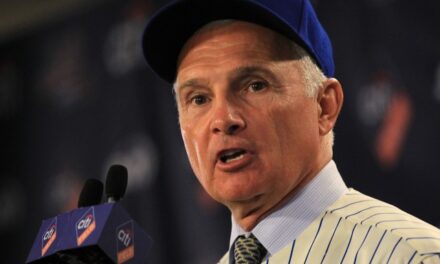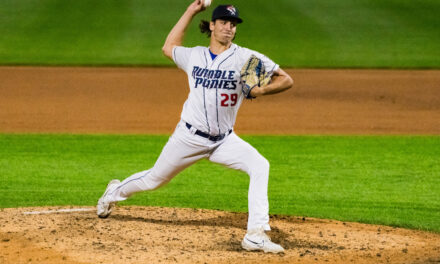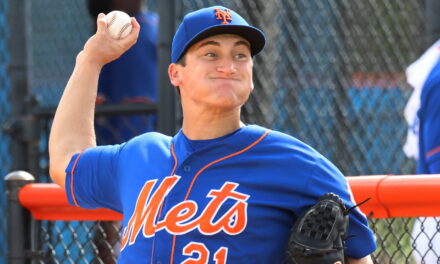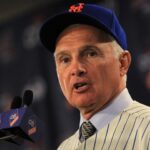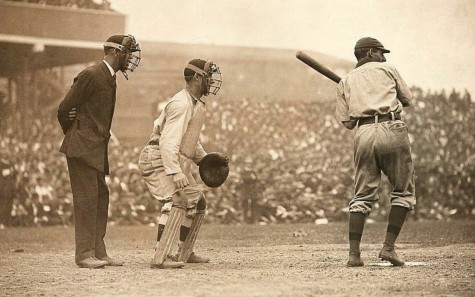
It’s the bottom of the ninth inning. The Mets are trailing 1-0. Up to the plate comes J.D. Davis, pinch-hitting for Tomas Nido. Ball four! Next up is leadoff batter, Brandon Nimmo, looking to get on base for the first time tonight. The starter rears back and unleashes a 3-2 fastball that is just outside and Nimmo runs down to first.
Starling Marte strides confidently to the plate. The opposing manager takes a slow walk to the mound and signals for the right-hander. While Roger McDowell trots towards the mound, Davey Johnson takes the ball from Dwight Gooden and Gooden leaves to a rousing ovation after pitching eight shutout innings, allowing only two singles to Marte and striking out ten 2022 Mets.
McDowell throws a low fastball to Marte, looking for a double-play grounder. Marte grounds the ball through the hole between Rafael Santana and Ray Knight, and Davis chugs around third with the tying run. Nimmo ends up on third and there’s still no outs.
Now it’s Francisco Lindor‘s turn. Lindor was 0-2 with a walk against Doc, but he is eager for a chance to solve McDowell and keep this nail-biter going.
Here’s the pitch and Lindor lines it into right field, where Darryl Strawberry fields it as Brandon Nimmo scoots home with the winning run!
In a game started by Dwight Gooden and Max Scherzer, the 2022 Mets defeat the 1986 Mets 2-1, even though they were outhit 6-4.
Using only a scoresheet and a set of role-playing dice, I played this game in about 30 minutes using the book Deadball, written by W.M. Akers, author and game designer by trade. Recently I sat down with William over Zoom to find out how the game and book came about, and what else he is working on.
Akers was born in Nashville and lived there until he went to college in New York. When I mentioned that RA Dickey was from Nashville, too, Akers said, “RA Dickey actually went to the same high school as my dad. I saw him speak one time. It was the year he won the Cy Young, a couple of months before he got traded to Toronto. And my dad was like hey this pitcher guy is talking at my high school for an alumni thing. And I said can I please go to that? I love this dude. He’s my guy. I got to say hello to him which was pretty cool.”
About childhood baseball fandom, he said, “No, I didn’t really start watching baseball until moved to NY. I was growing up during the height of the Braves dynasty, surrounded by Braves fans, so I knew I didn’t like the Braves because I knew all these obnoxious Braves fans all around me. I’ve always had a natural affinity for underdogs. I remember when I was a kid, and the Braves were playing the Yankees in the World Series. And I thought I don’t know who these Yankees are, but they seemed like the underdogs. I later learned that was slightly skewed.”
“When I was in high school, I became a big soccer fan and started to watch a lot of soccer and I was really interested in baseball because those were the two sports people say are boring. And I was like well I like this one boring sport and maybe I’ll like this other sport people think is boring.”
“I started doing a lot of reading about baseball and had a friend who was really into it and I decided if I get into college in NY, I’ll go hard for the Mets, and that happened to be 2006 which was an easy year to get into the Mets to the point where I thought these guys win all the time. Thankfully they kind of rectified that in the following years…2007, 2008, and 2009 were the years that forged me into a Mets fan. I was there beat-by-beat for the collapses. Oh, I get it now. This hurts, this stinks. I want more please.”
As a child he did not play baseball card and dice games, but he did play card games, “like Magic, and I had a Star Trek card game. And I played a lot of board games so that was always in my head, but I didn’t start thinking about making a baseball dice game until I started playing role playing games a lot in my 20s. Getting into that and figuring out how the dice worked, the correlation between those and baseball probabilities, there’s gotta be a way to do this.”
“Baseball’s a sport that is expressed through numbers, more that any other sport. You can look at the record page for Babe Ruth and understand what his career was. Also in baseball everything that happens is a discrete action. A pitcher is only trying to do one thing: get an out. And the batter is only trying to do one thing: hit the ball. But a soccer player with a ball at his feet could be trying to do hundreds of things.”
When he lived in New York during college, “I knew about [games like Strat-O-Matic and APBA] and I read about them and once I became a baseball fan, I thought they were really cool, but it’s expensive to get into Strat. It costs a lot of money to buy the set and you have to buy the set for each year. Since I never played it, I didn’t know if I liked it enough to spend the money to get into it. And so what I wanted to do with Deadball was to create something that was nimble enough that you could just buy the book and use it for any year, any league, any players. It would have a simple enough core framework that you could make it be what you want it to be.”
“It’s really cool watching fans and players make it their own thing and hack it apart and put it back together again and use it to reenact whatever version of baseball lives in their head, which is the one that matters.”
The two things that I got into at the same time that fed into that—I started keeping score of games for the first time because I hadn’t done that until around 2014 or 2015. And I started running role playing games all the time, so I was interacting with dice a lot. I love dice and I love games, and figuring out how games work. It’s my favorite thing about playing games, learning games.
I had the idea for it—it must have been 2016, 2017 and we were visiting family and the visit was overlapping with Opening Day because I planned it badly. And suddenly it was the first week of the season and I wasn’t going to watch any baseball games so I was losing my mind. There’s got to be a way for me to work out a baseball game to play here with just my stuff.
Originally, I made up a really simple game that was played with playing cards, which did not create a statistically accurate baseball thing, but I was doing it and using a homemade scoresheet to keep track of it. This was totally random and the numbers aren’t even right, but it still feels like baseball and I’m still like player number four has struck out four times and I hate him. I hate him so much. And this was just with playing cards. When I got home, I figured there must be a way to do this with dice.
In his experience running RPGs, he was teaching people how to use percentage dice, “so if you’ve got a 40 scale, you have a 40% chance of doing it. And I was like, well that’s the same as a batting average. So if you round off a batting average to two numbers, you can roll a hundred sided die against it and you can know whether this guy got a hit, and it will be statistically accurate and feel real. So that was sort of the beginning of it. I hacked out the really basic rules in like a night.”
I want something that I can play with baseball cards. I want to have a reason to buy baseball cards because I like to buy baseball cards. I’m not a collector or anything, they’re just fun to buy. And I buy like two or three packs every season and then I put them in a shoebox, and I enjoy having them. And I should just restrict myself that this will all be based on stats that are on the back of a baseball card. And originally, I was like well you just pull out baseball cards and you make a team and move the guys around the table and isn’t this fun. Then I switched to scoresheets and that’s a lot more nimble especially when you don’t have baseball cards lying around.
So that was the very beginning of it. And then I refined it, refined it, and refined it. And I taught myself math and a lot of probability in order to get the numbers as close to right as possible and then one day I was working on it and my wife saw me and she said you need to find a way to monetize this because you’re spending a lot of time on it, and I was like you’re right. I decided to put it on Kickstarter and make it into a real book.
The rest, they say, is baseball dice game history.
The game is delightfully simple and best of all can be used to play any real or imagined team against any other, with only the one-time cost of the book in print or electronic form. Just print out some scoresheets and find the stats for the teams you want to play or use the fictional player generator to create your own teams.
W.M. has provided a fictional Southern Circuit for players who want to lose themselves in an inclusive and rambunctious league of notable players such as center fielder extraordinaire, Lee Ann Stone, and speedy leadoff batter, Clyde Shaud, Jr. The book is generously illustrated with early baseball drawings that are in the public domain.
Since the publication of Deadball, Akers has published Deadball: 1909, Deadball: Year II, Deadball: Year III, and Deadball: Year IV to introduce new rules and variants of the baseball game, along with many more stories featuring the Southern Circuit, as well as other fun ways to use the game to create a unique baseball experience.
Right now, he is finishing up Deadball: Second Edition, which is on Kickstarter and has already reached early funding goals. This edition finalizes and streamlines rules and tables, and serves as a great starting point for new players. You can interact with Akers on Twitter @ouijum.



